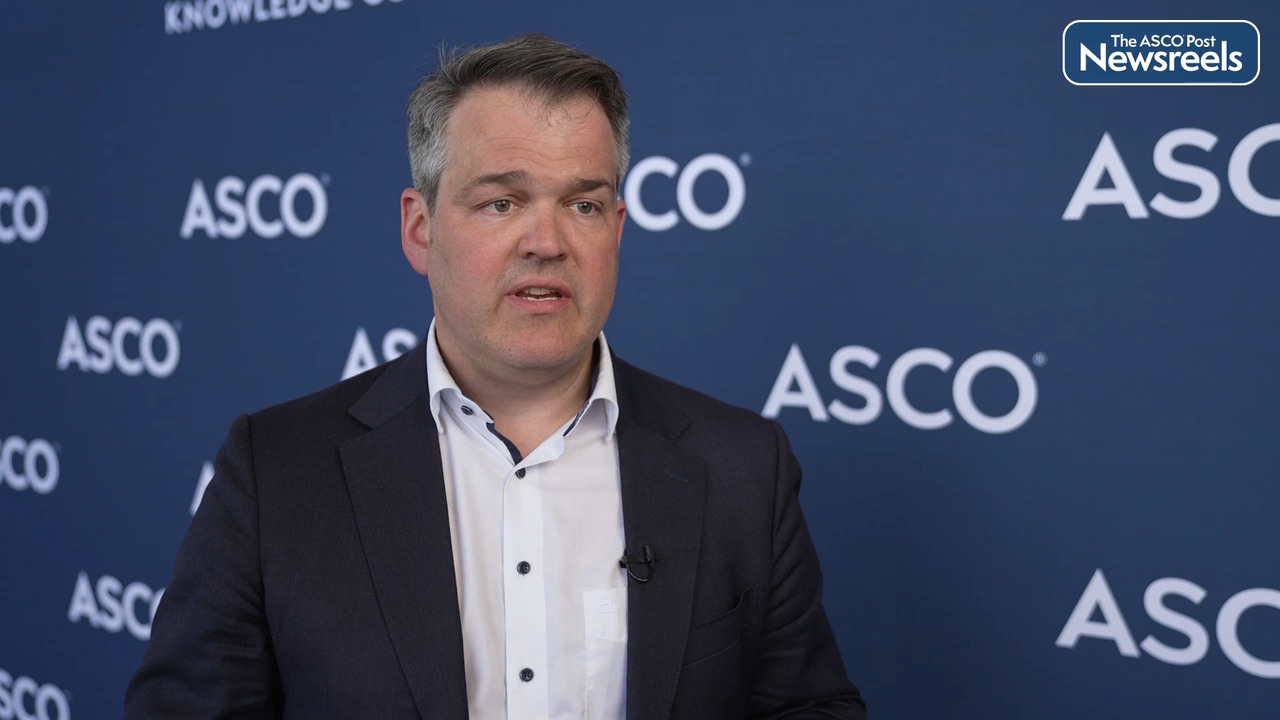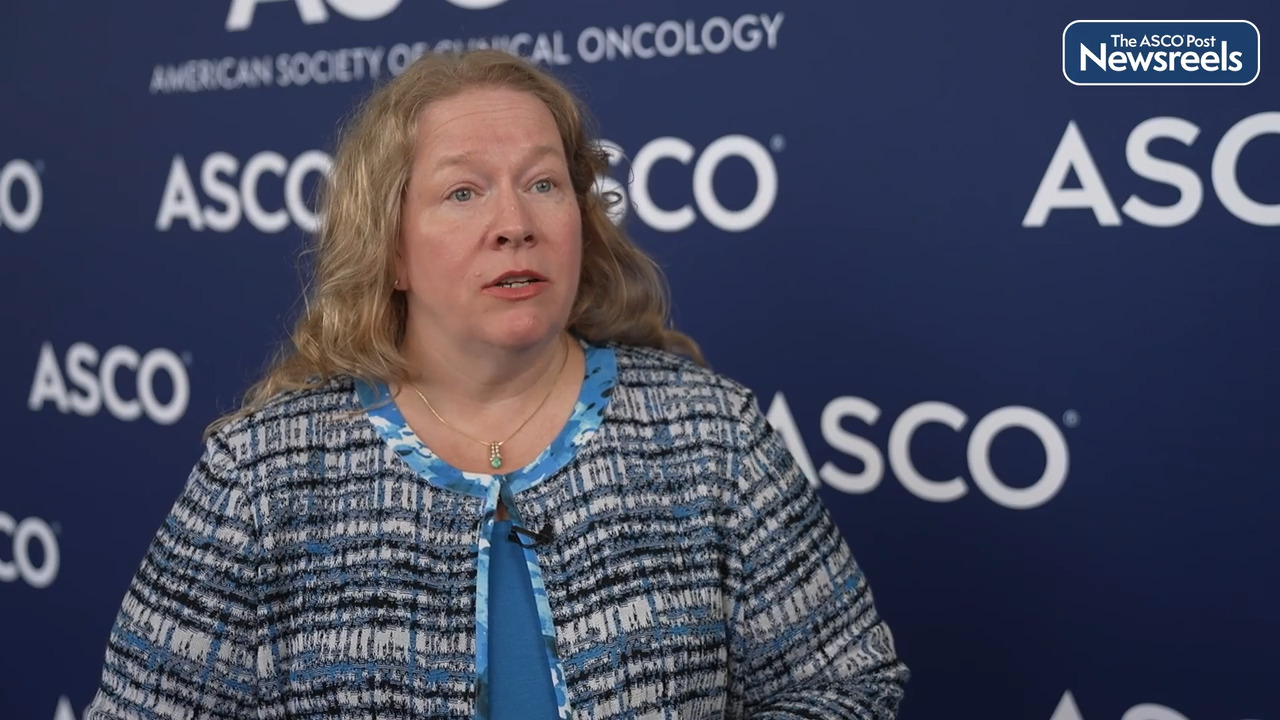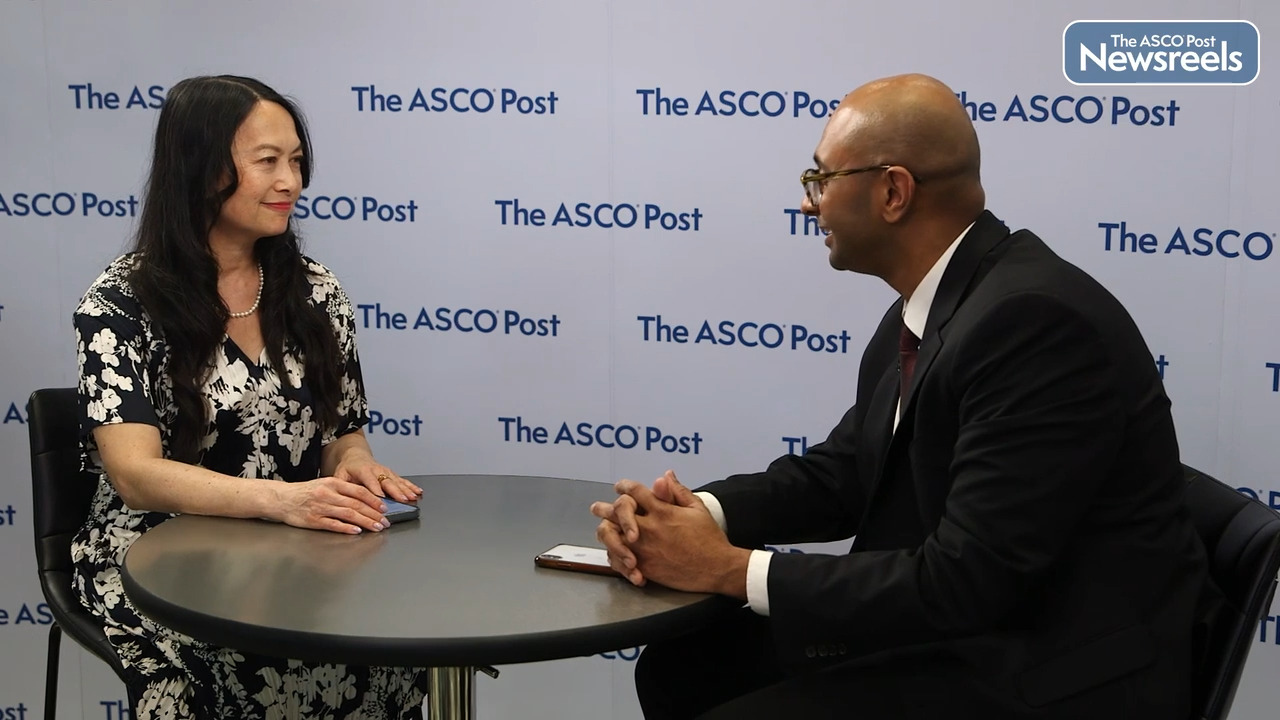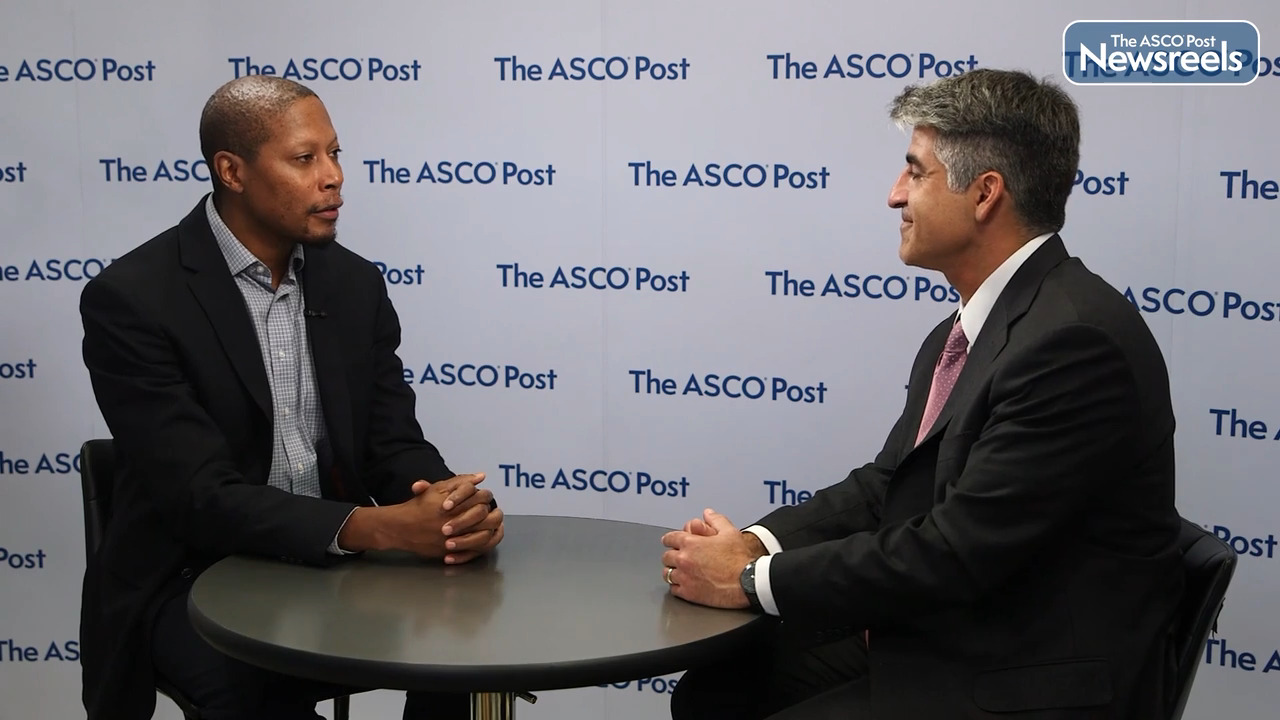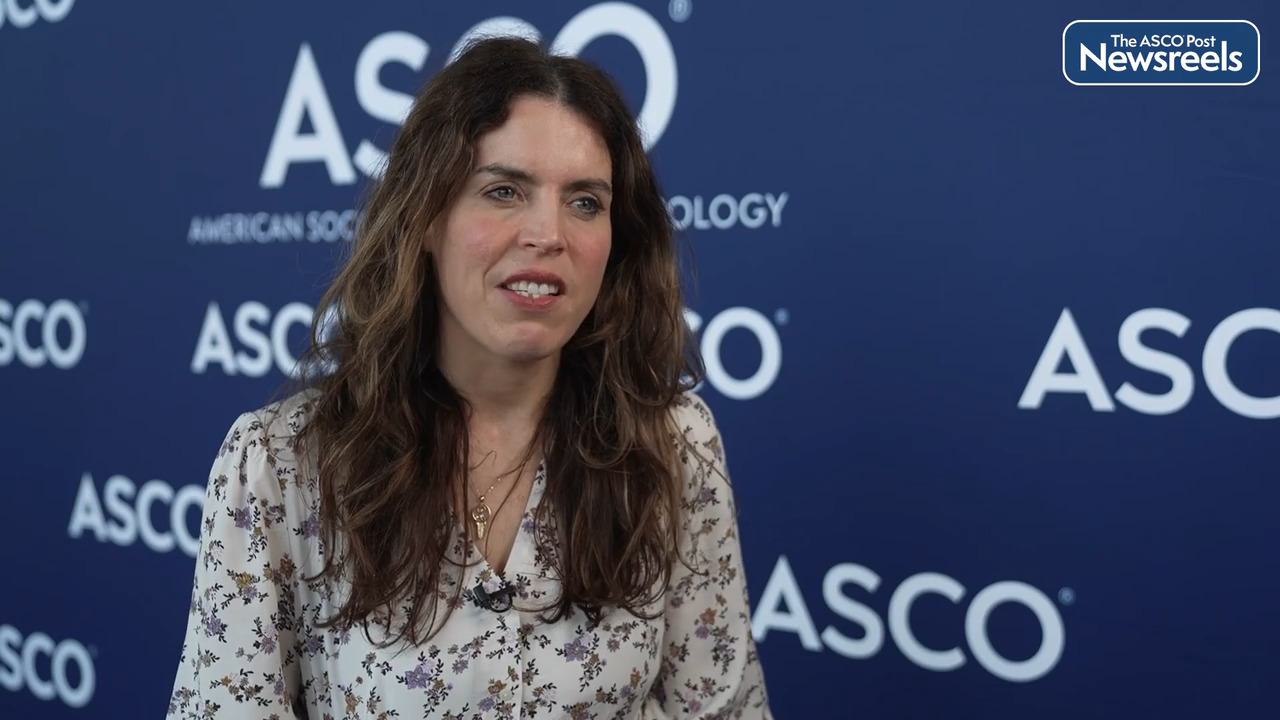Narjust Florez, MD, of Dana-Farber Cancer Institute, and Ticiana Leal, MD, of Winship Cancer Institute of Emory University, discuss the use of tumor treating fields therapy, in which electric fields disrupt processes critical for cancer cell viability. Already approved by the FDA to treat glioblastoma and mesothelioma, the treatment has extended overall survival in this phase III study of patients with metastatic non–small cell lung cancer (NSCLC) with progression on or after platinum-based chemotherapy, without exacerbating systemic toxicities (Abstract LBA9005).
Transcript
Disclaimer: This video transcript has not been proofread or edited and may contain errors.
Narjust Florez, MD:
So first before we talk about anything, what are the tumor treating fields?
Ticiana Leal, MD:
Tumor treating fields are electric fields that exert physical forces on electrically charged components of dividing cells. It has an anti-mitotic effect. So it disrupts mitosis and the downstream effects of that include that it leads to immunogenic cell death. It triggers a systemic antitumor immune response. So tumor treating fields therapy is a treatment that is delivered local regionally. So there's a portable medical device, and two pairs of arrays that are applied to the chest.
Narjust Florez, MD:
So these are vests that the patients will wear, where they receive the therapy.
Ticiana Leal, MD:
So these are adhesive bandages that are applied to the chest. And the company creates these personalized arrays that are outlines of the therapy, that are dependent on the size of the tumor, the CT scans of the patient. As well as whether they're male or female. And then these are prescribed by the clinician. And the device itself is actually delivered to the patient's home with 24/7 support from a device technician. That will come to the patient's home, explain how to use the device, and also to help troubleshoot the device.
Narjust Florez, MD:
This is really innovative. This is a device that we're bringing to a level of precision oncology. So could you summarize for us, and quickly, the design of the study that you're presented at ASCO?
Ticiana Leal, MD:
So the LUNAR study is a pivotal randomized Phase 3 study that included 276 patients. Randomized one-to-one to tumor treating fields therapy, plus standard of care. Which included immune checkpoint inhibitors, or docetaxel versus the standard of care. Patients then were followed every six weeks and continued on therapy until disease progression. The study was designed to evaluate the safety of an efficacy of tumor treating fields therapy plus standard of care, versus standard of care alone in patients with metastatic non-small cell lung cancer that had had progression of their disease on/or after platinum-based chemotherapy. So this is a population of high unmet need in the second line and beyond. As you know, after progression on docetaxel, or after progression on frontline chemo immunotherapy, there are limited treatment options. And our prior approval of docetaxel RAM was now back in 2014. So this is the first study since then that has shown an improved overall survival in this patient population.
Narjust Florez, MD:
So this is for heavily pretreated patients. And you are correct, this is a very large need. So what are some of the main results from this study that you can share with us?
Ticiana Leal, MD:
The primary endpoint of the study is overall survival in the ITT population, which included patients treated with immune checkpoint inhibitors as well as docetaxel. The primary endpoint of overall survival was met. The study showed that the addition of tumor treating fields to standard of care, led to a statistically significant improvement in overall survival. We saw median overall survival of 9.9 months in the standard of care arm, to 13.2 months in the experimental arm. The P-value and the hazard ratios were statistically significant. The hazard ratio is 0.74, with a P-value of less than 0.035. So this is something that is practice changing. It's potentially a paradigm shift in how we treat non-small cell lung cancer in the second line and beyond. And importantly, without added systemic toxicities and no negative impact on health related quality of life measures that we looked at in this study.
Narjust Florez, MD:
As we're almost finishing the conversation, what were some of the unique adverse events from the tumor treating fields therapy?
Ticiana Leal, MD:
Overall, the treatment was well tolerated. Thinking about grade three adverse events, or greater, between the two arms, they were very similar. The one key adverse event that was unique to tumor treating fields was dermatitis. All grades dermatitis was seen in 43% of the patients. However, grade three or higher adverse events was quite low, at about 2%. So the majority of these events of dermatitis were grade one and two in nature. And dermatitis resolved in 87% of the cases. The median duration was about three weeks.
Narjust Florez, MD:
Anything else you would like to add from the study for our listeners.
Ticiana Leal, MD:
I'd like to highlight some of the other endpoints of our study. Secondary endpoints of the study included overall survival in the ICI or immune checkpoint inhibitor treated subgroups, as well as the docetaxel treated subgroups. In the immune checkpoint inhibitor treated subgroups, we actually saw a really striking improvement in overall survival. Where the median overall survival nearly doubled from 10.8 months in the immune checkpoint inhibitor alone group, versus 18.5 months in the TTF plus ICI subgroup. And there we saw hazard ratio of 0.63, with a P-value of 0.005. In addition, in the docetaxel treated subgroups, we saw there that the median overall survival in the docetaxel alone arm was 9.9 months, versus 11.1 months in the docetaxel TT field subgroup. The hazard ratio there is 0.81, and the P-value is 0.28.
Narjust Florez, MD:
And my last question is, how would you explain this study to a patient and their families?
Ticiana Leal, MD:
So this study to patients and to their families, I would explain that the results of the LUNAR trial led to improved survival, helping patients live longer with the addition of tumor treating fields to standard of care therapy. Explaining to them that this is a medical device. This is a medical device that patients have to have at home. It's supplied local regionally with two pairs of adhesive bandages that are applied to the chest, according to a plan that is specifically created for them by the company to treat their tumors.
In addition, I would explain to them that the recommendation is for use that is continuous use. The target here is to use it for 75%, or greater, in their day. They do have to carry the device with them while they're using it, either in a backpack, or maybe a purse, or something that it will fit the device in. And then importantly, they'll continue their care with their clinician in the clinic coming in for their systemic therapy. Whether that's an immune checkpoint inhibitor or docetaxel. And then certainly would educate them on what to watch out for in terms of side effects. Specifically the dermatitis, and then how to manage the dermatitis in the clinic.
Narjust Florez, MD:
Thank you so much, Dr. Leal. This is certainly very innovative. And thank you for your time with the ASCO Post.
Ticiana Leal, MD:
Thank you.
